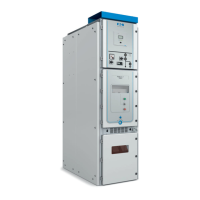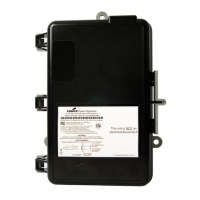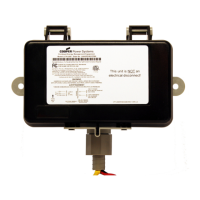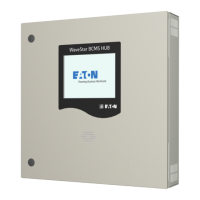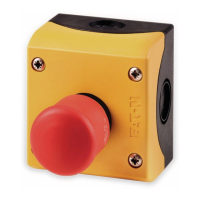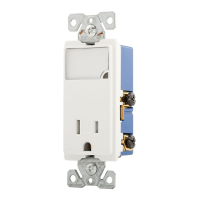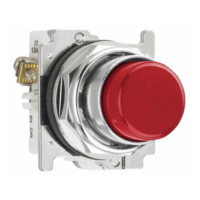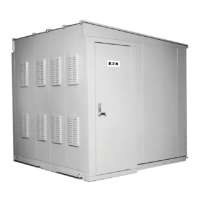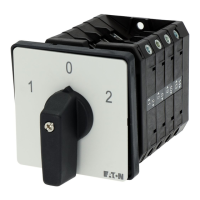17
Instruction Manual IM01500001E
Effective July 2011
Pow-R-Line switchboards
EATON CORPORATION www.eaton.com
Switchboard insulation resistance testing
Maintenance before cleaning
Prior to cleaning, perform an initial Megger or DC test of the switch-
board insulation, between phases and ground. Inspect for symptoms
that may indicate overheating or weakened insulation. Record test
readings. Refer to NEMA publication AB-4, Guidelines for Inspection
and Preventative Maintenance of Molded-Case Circuit Breakers
Used in Commercial and Industrial Application.
Prior to testing, remove all control power fusing and connections
to products, which will be damaged in this test. This includes all
components with control wire fusing, transient voltage surge
suppression, surge protective devices, metering equipment,
and so on.
WARNING
TO PREVENT DAMAGE TO GROUND FAULT CONTROL CIRCUITS, METERING
CIRCUITS, SURGE PROTECTIVE DEVICE (SPD), OR OTHER CONTROL
CIRCUITS. WHEN MEGGERING SWITCHBOARD, ISOLATE CIRCUITS FROM
SWITCHBOARD SYSTEM BEFORE BEGINNING THE MEGGER OPERATION.
BE SURE TO RECONNECT THOSE CIRCUITS AFTER MEGGER TESTS
ARE COMPLETED.
NOTE: SOME GROUND FAULT CIRCUITS MAY NOT BE FUSED; THEREFORE,
ISOLATION OF THOSE CIRCUITS REQUIRES DISCONNECTING WIRING
FROM BUSBARS.
DO NOT USE AC dielectric testing.
WARNING
DO NOT USE ALTERNATING CURRENT (AC) DIELECTRIC/ MEGGER TESTING.
DAMAGE TO COMPONENTS WILL OCCUR.
Cleaning
While the switchboard is de-energized, remove dust and debris from
busbars, connections, supports, and enclosure surfaces. A vacuum
cleaner with a long nozzle will be of assistance. Wipe clean with a
lint-free cloth. Do not use solvents to clean equipment, as damage
to surfaces can occur.
Should the switchboard be exposed to adverse conditions, such as
airborne contaminants, more frequent inspections and cleaning may
be required.
WARNING
DO NOT USE COMPRESSED AIR TO CLEAN OR BLOW OUT DEBRIS OR DUST
IN SWITCHBOARDS.
Use of compressed air to clean or blow out debris in switchboards
may imbed the contaminants within overcurrent devices, metering
equipment, and other components. Damage to insulation and other
surface materials can occur. Do not use compressed air in cleaning.
Switchboard insulation resistance testing
Maintenance after cleaning
After cleaning, perform a second Megger or DC test of the switch-
board insulation between phases and ground.
Prior to testing, remove all control power fusing and connections
to products, which will be damaged in this test. This includes all
components with control wire fusing, transient voltage surge
suppression, surge protective devices, metering equipment,
and so on.
WARNING
TO PREVENT DAMAGE TO GROUND FAULT CONTROL CIRCUITS, METERING
CIRCUITS, SURGE PROTECTIVE DEVICE (SPD), OR OTHER CONTROL
CIRCUITS. WHEN MEGGERING SWITCHBOARD, ISOLATE CIRCUITS FROM
SWITCHBOARD SYSTEM BEFORE BEGINNING THE MEGGER OPERATION.
BE SURE TO RECONNECT THOSE CIRCUITS AFTER MEGGER TESTS ARE
COMPLETED.
NOTE: SOME GROUND FAULT CIRCUITS MAY NOT BE FUSED; THEREFORE,
ISOLATION OF THOSE CIRCUITS REQUIRES DISCONNECTING WIRING
FROM BUSBARS.
DO NOT USE AC dielectric testing.
WARNING
DO NOT USE ALTERNATING CURRENT (AC) DIELECTRIC/ MEGGER TESTING.
DAMAGE TO COMPONENTS WILL OCCUR.
Test resulting in readings at or above 1 megaohm is satisfactory.
Compare these test readings with prior readings and retain with
previous testing for future comparisons. Trends of lowered insulation
resistance are signs of potential problems. A Switchboard Inspection
Log form is provided in Appendix B to record readings.
Bus and cable connections
1. Inspect busbar and cables for visible damage.
2. Visually inspect connections for overheating and damage.
3. All busbar and cable connections should be checked and
torqued in accordance with labeling on the switchboard.
Refer to Appendix A, Table 2 for torque values.
4. Inspect for broken wire strands and pinched or damaged
insulation on cable connections.
Insulation
All busbar and structure insulation in the switchboard, including bus
supports, bus shields, bus bracing, insulating barriers, and so on,
should be visually checked for damage. Replace damaged parts.
The life of insulation material is dependent on keeping the material
dry and clean.

